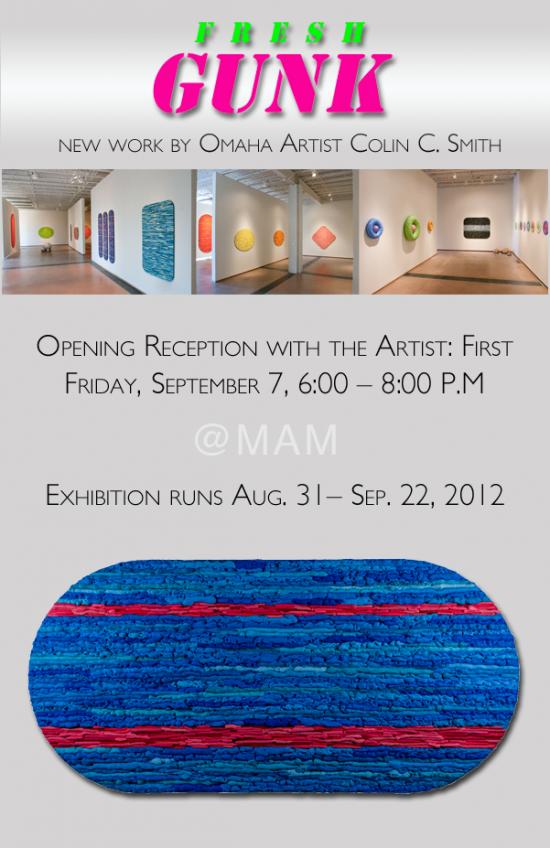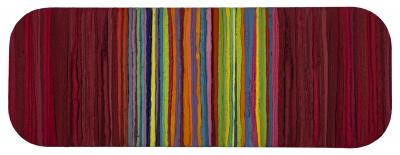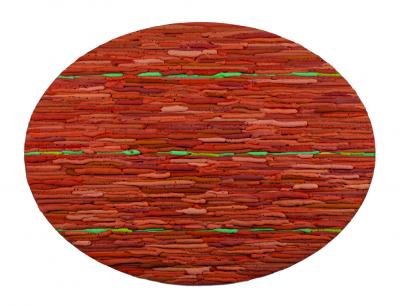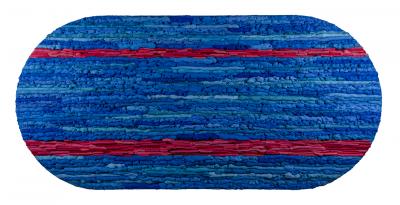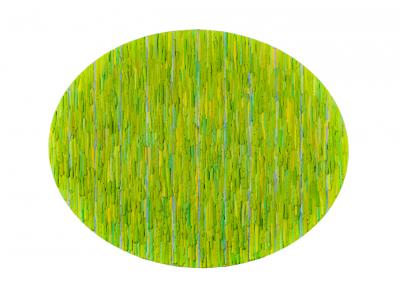Fresh Gunk 9.7.12
New Painting and Sculpture from Colin C. Smith at Modern Arts Midtown
-by Michael J. Krainak, Freelance Writer in the Visual Arts
The very title of Colin C. Smith’s new body of work, Fresh Gunk, more than hints at the paradoxes to follow in his current exhibit at Modern Arts Midtown. Laundry just out of the dryer and a new pot of coffee are “fresh,” but “gunk”? Yet, Smith’s latest variation on a theme of gunk is exactly that. Fresh, not merely because it is new and surprising but because it is also bold and imposing like an unexpected kiss both public and personal.
Fresh Gunk consists of more than 25 2-D and 3-D pieces individually or in groups such as paintings, Omegas, Pans and Pylons. Each series continues the artist’s experimentation with a mix of pigment, resin and foam that Smith discovered quite by accident and has processed into a now signature style.
Whether the layered striations of his paintings, the foaming crust of his Omegas and Pylons or the molten globules in his Pans on wheels, Smith’s aesthetic is all about pure, scintillating hues, texture, patterns and those seeming contradictions of formality and spontaneity. No matter the shape or form, each individual work of colorful, sculptural or layered simplicity elicits an immediate response from the viewer of faint recognition and strong sensuality.
Which is to say his works are meant to look and feel like something familiar in a way that isolates and concentrates the sensation and only suggests the intended object. This is particularly true of his paintings that crackle and pop with titles like “Buzz,” “Echo,” “Blush,” “Ripple” and, yes, even “Snap.” The standing and wall sculptures exude so much presence and energy they need only be labeled by their categories.
Labels don’t come easily to Smith who eschews classifications of convenience and confinement. An Omaha native, he earned his BFA from UNO in 1988 and an MFA from Drake University in 1992. This writer became aware of his art earlier in this decade at two interesting shows at the former Fluxion Gallery and the Hillmer Gallery at the College of St. Mary. His work had evolved into flat panel renderings that utilized automotive paint. Though his dynamic graphic patterns satirized a contemporary digital age, it also referenced the modernism of the ‘50s and ‘60s, particularly the California finish fetish style.
As Smith’s art continued to evolve, it did so less by design and more by spontaneity, allowing for moments of serendipity. Chief among his mentors was the late Jesuit artist and Creighton University professor, Rev. Leland Lubbers, the founder of SCOLA, an international satellite network. It was Lubbers, he said, who “introduced me to reality.” It is the sort of “reality” another influential artist, Robert Irwin, theorized about in Lawrence Weschler’s book, Seeing is Forgetting the Name of the Thing One Sees: “Everything becomes real and experiential in the moment.” In short, Fresh Gunk displays the wide-eyed imagination of a young, inspired artist who accepts his instructor’s assignment with abandon and whatever else that moves him. Smith attributes this in no small part to his new studio assistant, 10-year-old daughter, Olivia, also an artist, critic and collaborator.
What then to think of Fresh Gunk as it dazzles the eye and engages the spirit? Smith would have one not think at all if it separates one from the experience of the art first and foremost. Especially if one tries to “figure it out” or solve its acknowledged paradoxes of play and seriousness, systematic and intuitive, minimal and expressionistic, and sculptural and painterly. And don’t look to him to resolve the conundrums. “I’m a question artist,” he says with bemusement.
One of the questions Smith seems to ask in this exhibit is: Does art need to follow tradition and be classified in order to be appreciated, let alone created? Breaking from tradition is the nature and history of art including Abstract Expressionism’s rebellion against the Renaissance Window, and in turn the Modernist Grid’s response to the former. Though Smith rejects such association with abstraction in any form, Fresh Gunk does reveal familiar shapes and patterns but with one interesting variation. In his hands, the grid appears to be melting, dripping and oozing to the floor, shape-shifting as it were, and re-defining the space it occupies.
Hesse McGraw, chief curator of the Bemis Center for Contemporary Arts, appreciates Smith’s experimentation with form and medium and has featured him in two significant group shows, Borderland Abstraction at Bemis in 2010 and more recently in Not Here No There at the Dolphin Gallery in Kansas City, Mo. Most of all, McGraw recognizes in both exhibits that there are some artists who not only rock the very boat they may be in, but also, as in the above, “prefer to explore the vibrant cracks in between contemporary abstraction.”
In a 2009 studio visit McGraw said he saw “a dramatic shift in (Smith’s) work. What happens when you have an idea about a painting and make it physical? Previous paintings of his were about depictive and represented space and were extraordinarily flat. Now he’s playing with form in a very sensuous way. I think he thinks all his works are paintings. Now the paint has developed mass. He’s a master of materials.”
One glance around the front rooms of MAM confirms that Fresh Gunk may well be a master of space due to the curatorial skills of Smith and gallery owner and artist Larry Roots. Certain interior walls have been painted a light grey so that virtually all the work enjoys the same tonal backdrop regardless of light source. Hung or placed in such a neutral way allows each piece to seek its own space as the wall disappears. So dominant is the work because of this, as well and its excellent sightlines, it references what well-known painter Ellsworth Kelly once said about displaying and viewing artwork: “I am not interested in painting as it has been accepted for so long to hang on the walls of houses as pictures. To hell with that…they should be the wall.”
To that end individual paintings here enjoy a conversation with others across from them at various distances based on complementary colors and contrasting shapes and temperatures. This is particularly true of the cool sublime blues of “Shag” and “Echo” and the hot-blooded reds of “Bounce” and “Fuse.” Then, just as the eye reverberates around the gallery with these contrasts, Smith brings it all together strategically in such works as the rainbowesque “Ripple” and the kaleidoscopic “Tutu.” The rounded and frameless corners of all the paintings, along with the paradoxically strong vertical and horizontal patterns, allow them to expand because while there may be an edge to each, there is no artificial barrier to the mind’s eye.
Though viewing Fresh Gunk is primarily a visceral experience, one can’t be blamed for attempting to identify with the work, as well as in imagining a mossy river bank in “Buzz” or the solemnity of church in the triptych “Cycle” that resembles stained glass windows. Even Smith joins in on the fun with his silver encrusted Pylons, totem-like fantasies that conjure up Emerald City and the futuristic, sci-fi Omegas with their rings orbiting a moon or planet. In truth, Fresh Gunk is neither representational nor merely abstract, but it is always sensual and suggestive of much of what is in nature and everyday life. It is never the “thing,” but it is often the essence of that thing: a stained glass window, a grandmother’s roll of yarn or video test pattern. By isolating on and concentrating its form, color, texture and material, Smith transforms the ordinary into the shapes we imagine.

